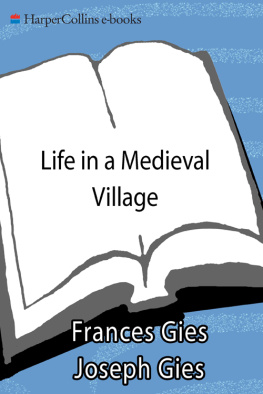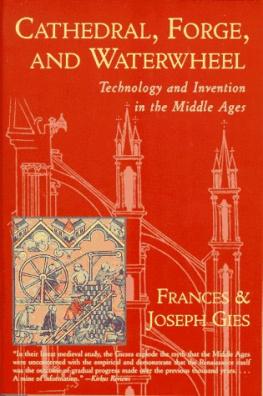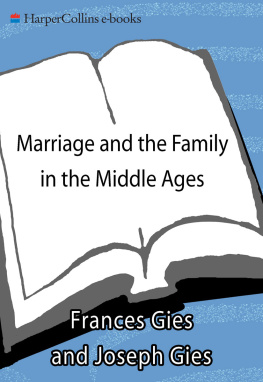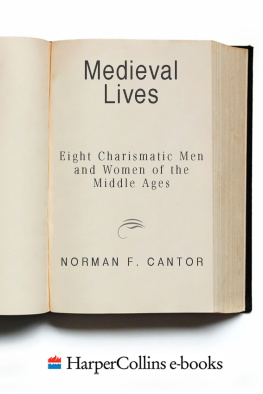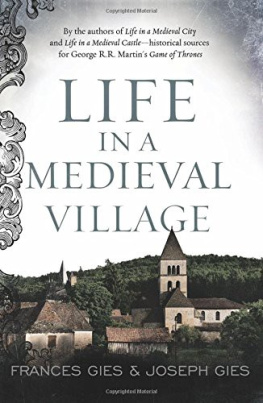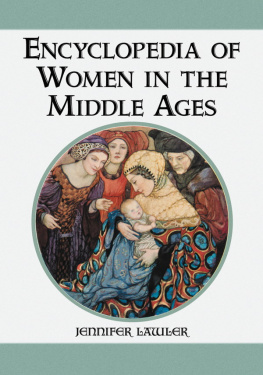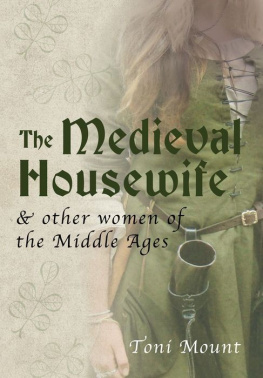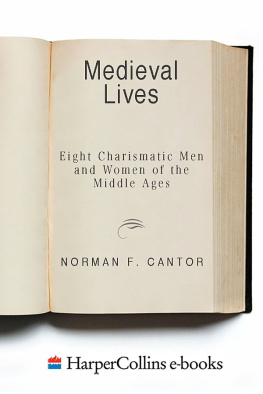Frances Gies - Women in the middle ages : the lives of real women in a vibrant age of transition
Here you can read online Frances Gies - Women in the middle ages : the lives of real women in a vibrant age of transition full text of the book (entire story) in english for free. Download pdf and epub, get meaning, cover and reviews about this ebook. year: 2017, publisher: HarperCollins, genre: History. Description of the work, (preface) as well as reviews are available. Best literature library LitArk.com created for fans of good reading and offers a wide selection of genres:
Romance novel
Science fiction
Adventure
Detective
Science
History
Home and family
Prose
Art
Politics
Computer
Non-fiction
Religion
Business
Children
Humor
Choose a favorite category and find really read worthwhile books. Enjoy immersion in the world of imagination, feel the emotions of the characters or learn something new for yourself, make an fascinating discovery.

- Book:Women in the middle ages : the lives of real women in a vibrant age of transition
- Author:
- Publisher:HarperCollins
- Genre:
- Year:2017
- Rating:4 / 5
- Favourites:Add to favourites
- Your mark:
- 80
- 1
- 2
- 3
- 4
- 5
Women in the middle ages : the lives of real women in a vibrant age of transition: summary, description and annotation
We offer to read an annotation, description, summary or preface (depends on what the author of the book "Women in the middle ages : the lives of real women in a vibrant age of transition" wrote himself). If you haven't found the necessary information about the book — write in the comments, we will try to find it.
Women in the middle ages : the lives of real women in a vibrant age of transition — read online for free the complete book (whole text) full work
Below is the text of the book, divided by pages. System saving the place of the last page read, allows you to conveniently read the book "Women in the middle ages : the lives of real women in a vibrant age of transition" online for free, without having to search again every time where you left off. Put a bookmark, and you can go to the page where you finished reading at any time.
Font size:
Interval:
Bookmark:
in the
MIDDLE
AGES

To Dory with love
THE BACKGROUND
Women in History
Traditional history, all about politics, wars, and revolutions, has devoted few pages to women because few women were prominent in those male-dominated activities. The handful who were received patronizing credit for behaving like mena woman led an army with a mans courage, an able queen ruled as if she were a man.
Modern history, with its accent on the economic, social, and cultural, is beginning to give woman her due. Yet many problems need to be overcome before a picture of the past as a cooperative adventure of both sexes will emerge.
Attempts to do justice to women of the Middle Ages have encountered special difficulties owing to the character of the sources commonly used. The writings of Church Fathers, theologians, and preachers have been repeatedly cited, with little consideration of the accuracy of their description of conditions, or of their audience and influence. By a similar method of investigation one might conclude that modern Catholics never practice birth control. Law books and manuals have also been misleading. William Blackstones eighteenth-century pronouncement that women throughout ancient and medieval history were totally bereft of legal rights and even legal identities was until recently uncritically accepted. Finally, literary worksromances, poems, moral essays, taleshave been taken literally, without allowance for artistic exaggeration or satiric intent.
Apart from the problem of sources, the test of common sense has been difficult to apply to ideas about medieval women because the period is so remote to us, more remote not only than the modern era but even than the classical world. Its social institutionsfeudalism, the manorial system, the guildsseem oddly foreign and artificial. The very domicile of the ruling class, the grim and forbidding castle, seems legendary rather than historic, while armor, tournaments, chivalric codes, the ritual and trappings of knighthood, have a science-fiction outlandishness. The people, men as well as women, seem unreal, like the stiff decorative figures in the illuminated manuscripts and stained-glass windows, rather than our own flesh-and-blood forebears.
Finally, the time frame is confusing. The Middle Ages lasted a thousand years, during which large changes swept the European landscape: the peoples migrations, infusing new ideas as well as new blood into the politically disintegrating Roman Empire; calamitous economic decline and vigorous revival; technological innovations with far-reaching effects; social upheavals that created new class relationships. Womens lives were changed along with mens. Few generalizations can be made about womens role that will fit the whole dynamic millennium.
For the early Middle Ages, documentation is limited because of the very nature of the epoch. The next chapter briefly summarizes what is known about womans situation in that fascinating and, to the historian, frustrating erathe period of the migrations, the barbarian kingdoms, and the economic slow-down known as the Dark Ages. The remaining chapters in the first section describe some of the changes which took place at the end of the Dark Ages, and the principal attitudes toward women that prevailed.
The second, and main, section of the book explores what it was like to be a woman in the high Middle Agesthe period from about 1100 to 1500by examining the lives of individual women in those centuries. The information comes principally from real-life sources: chronicles, tax rolls, legal and manorial records, private account books, diaries, letters.
What are the elements that affect a womans life? Recent works in womens history have tended to focus on the status of women relative to men. But the first and most important consideration in evaluating the quality of life in the Middle Ages applies equally to men and women: the technological and economic level of a low-energy but expanding society, influencing work, housing, food, clothing, health, security, comfort, and self-fulfillment.
A second basic element, affecting only women, is the state of obstetrical practice. Throughout the ages, until antisepsis and improvements in obstetrical techniques arrived in the nineteenth century, childbirth was a mortal hazard. Rich or poor, women suffered and were injured in labor; often they died. A medieval gynecological treatise, The Diseases of Women, from the medical school at Salerno, reflects the problems and horrors of childbirth in the whole pre-industrial era, during which doctors and midwives had few aids other than potions and poultices. Nevertheless, amid prescriptions for rubbing the womans flanks with oil of roses, feeding her vinegar and sugar, powdered ivory, or eagles dung, placing a magnet in her hand or suspending coral around her neck, the Salernitan text also gives sound advice, for example on breech delivery: If the child does not come forth in the order in which it should, that is, if the legs or arms should come out first, let the midwife with her small and gentle hand moistened with a decoction of flaxseed and chick peas, put the child back in its place in the proper position.
Although abortion, with its own dangers, was practiced from very ancient times, contraception, by various methodsmechanical, medicinal, and magicalfound limited use and even less effectiveness. Women had babies, successfully or otherwise.
Several other special criteria apply to the quality of a womans life in any historical setting.
First, simple survival: in many times and on different continents, women have been victims of infanticide as a technique of selective population control. The reason, although usually rationalized in terms of the females alleged weakness of physique, character, and intellect, is transparently economic: the contribution in work of a daughter was often outweighed by the cost of raising her and giving her a marriage portion: investment in a daughter went mainly to the profit of a future husband.
Second, conditions of marriage: the question of consent; the relative age of consent for men and women; monogamy versus polygamy, which emphasizes womans biological role at the expense not only of her personal, but of her social and economic roles; the seclusion of women in harems or gynaeceums, or their privatization at home, where they were segregated from the male spheres of business, politics, and religion; attitudes toward adultery and divorce, where a double standard nearly always prevailed.
Property rights: a womans competence to own land in her own right; to inherit, to bequeath and sell property; to conduct a business in her own name; to dispose of her own dowry or marriage portionthe money, land, or valuables contributed by her parents when she married.
Legal rights: the restrictions upon women in taking legal action, suing, pleading in court, giving evidence, witnessing wills.
Education: the relative level of literacy or cultivation of men and women.
Work: the distinction between mens work and womens work; of outside and inside jobs, the big jobs being outside, the little ones at home. Throughout most of history, activities within the house have been considered feminine, with a strong connotation of inferior importance, although they covered the whole process of textile manufacturing and almost every stage of food cultivation and preparation. In addition, women joined men in many of the outside jobs, working in the fields, in the shops, even in the mines, usually at lower wages.
Font size:
Interval:
Bookmark:
Similar books «Women in the middle ages : the lives of real women in a vibrant age of transition»
Look at similar books to Women in the middle ages : the lives of real women in a vibrant age of transition. We have selected literature similar in name and meaning in the hope of providing readers with more options to find new, interesting, not yet read works.
Discussion, reviews of the book Women in the middle ages : the lives of real women in a vibrant age of transition and just readers' own opinions. Leave your comments, write what you think about the work, its meaning or the main characters. Specify what exactly you liked and what you didn't like, and why you think so.

